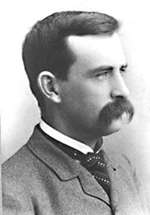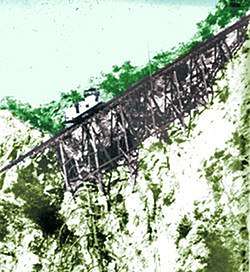David Macpherson (engineer)
David Joseph Macpherson (born January 12, 1854, in Canada West – died October 16, 1927, in Pasadena, California, United States), was a civil engineer graduate from Cornell University.
David J. Macpherson | |
|---|---|
 | |
| Born | January 12, 1854 Canada West |
| Died | October 16, 1927 (aged 73) Pasadena, California, United States |
Early career
His first work was as a city planner for San Antonio, Texas, but he is more recognized for his work on railroads, specifically the one from Ciudad Juárez to Mexico City, and the Santa Fe Railroad.
He was the sole survivor of six children who died from consumption or other diseases. This prompted his move to Pasadena, California, in 1885. Pasadena was known for its climate conducive to good health. There he moved into a Dutch Colonial home in the unincorporated area of the Pasadena Highlands.
Mount Lowe Railway
Though he spent time in developments in Pasadena, and was even once the Chairman of the Pasadena Board of Education, he wandered extensively about the foothills conjuring ideas about the development of a scenic mountain railroad to the crest of the San Gabriel Mountains. This idea had been brought up many times by the locals of Pasadena and Sierra Madre alike. It was not until he was introduced to the millionaire Professor Thaddeus S. C. Lowe by Perry M. Green, president of the Pasadena First National Bank, that any idea of funding such a venture came to the fore. Lowe retired to Pasadena from Norristown, Pa., and moved into a 24,000 sq ft (2,200 m2). mansion on Orange Grove Blvd., Pasadena in 1890.

Together the men formed the Pasadena & Mt. Wilson Railroad and made plans for a steam cogwheel train to the summit of Mt. Wilson, the likes of which would rival the ones at Mt. Washington, Vermont, and Pikes Peak. Unable to obtain rights of way, the men turned their plans in the direction of Oak Mountain, to become Mount Lowe. The plan for the Mount Lowe Railway was also changed to incorporate an electric streetcar or trolley and a cable car funicular.
Macpherson's designs of trestles and bridges went beyond the engineering standards of the day, particularly the Macpherson Trestle, which was designed to negotiate a deep granite chasm along 500 feet (150 m) of track on a 62% grade.
Altadena
Macpherson acquired the narrow strip of land on which his house was settled, which ran not more than a block wide and a mile in length through the Pasadena Highlands and into Altadena. He laid out the streets and named them after his favorite American railroads, south to north: Washington Street; Rio Grande St.; Denver become Howard St.; Santa Fe become Elizabeth St.; Topeka St.; Atchison St.; Erie become Woodbury Rd. east of Lake; New York Dr.; Albany become closed (portions renamed Sonoma Dr); Maine become closed; and Boston St.
In 1920 he built a new home on the corner of Atchison and Mar Vista which, after Pasadena annexation was stopped, remains in Altadena.
References
- Seims, Charles (1976). Mount Lowe, The Railway in the Clouds. San Marino, CA: Golden West Books. ISBN 0-87095-075-4. LCCN 76-45760.CS1 maint: ref=harv (link)